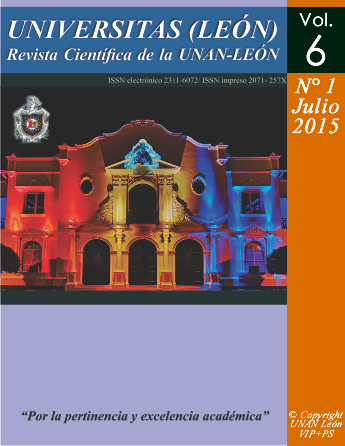Growth of tilapias oreochromis niloticus in monosexual culture and both sexes, in semi-intensive production systems
DOI:
https://doi.org/10.5377/universitas.v6i1.13697Keywords:
Tilapia farming, Tilapia farming by sexAbstract
Target. To compare the population parameters of Oreochromis niloticus tilapias grown in Monosexual and Both-sex cultures in semi-intensive production systems. Materials and methods. To determine which treatment obtained the highest growth, physical-chemical factors (Dissolved Oxygen, Temperature) and population parameters (Accumulated Growth, Survival and Feed Conversion Factor) were taken. Collecting these data for 25 days where the Tilapia Oreochromis niloticus had an initial weight of 77.43gr in both treatments. Results. According to the results obtained in the experiment, the monosexual treatment acquired a final growth of 135.42gr, obtaining an average of 57.99 gr, while the treatment of both sexes reached a final growth of 112.73gr, achieving an average of 35.3 gr. Conclution. The monosexual treatment gained greater size and biomass in less time since they only dedicated themselves to feeding, on the other hand in the treatment of both sexes they gained little biomass since the ingested food was used for the preparation of sexual maturation and thus enter the reproductive stage, which decreased its growth rate, when applying the statistical analysis it was found that p>0.05 alleging that the growth of Tilapia Oreochromis niloticus is greater when only males are cultivated.
Downloads
References
Anónimo 3. 2000. Manual de Crianza Tilapia. Alimentos Balanceados. Nicovita-Lima. Perú. 49pp. Disponible en: http://www.industriaacuicola.com/biblioteca/Tilapia/Manual%20de%20crianza%20de%
tilapia.pdf
Anónimo 5. 2004. Cultivo de Tilapia. Vice ministerio de pesquería, Dirección nacional de acuicultura. Lima - Perú. 5-9pp. Disponible en: www.innovacion.gob.sv/.../Cultivo%20De%20Tilapia,%20Lima%20-%2
Bhujel, R.C. (2000) A review of strategies for the management of Nile tilapia broodfish in seed production systems, especially hapa-based systems.Aquaculture 181, 37-59pp. Disponible en: http://africhthy.org/content/review-strate gies-management-nile-tilapia-oreochromis-niloticus-broodfish-seed-production-sy https://doi.org/10.1016/S0044-8486(99)00217-3
Díaz, M. Alva, R. 2012. Cultivo semi-intensivo de tilapia, Oreochromis niloticus, en estanque de concreto en el caserío Palo Blanco (Cascas, La Libertad-Perú). Universidad Nacional de Trujillo. Trujillo. Perú. 99pp. Disponible en: www.facbio.unitru.edu.pe/index.php?option=com_docman
Gunter, 2000. Guía para el cultivo de Tilapia. Primera edición impreso en Mexico. 138 pp. Disponible en: www.inapesca.gob.mx/portal/documentos/.../1memoriastilapia1.pdf
Little, D. C., & Edwards, P. (2004).Impact of nutrition and season on pond culture performance of mono-sex and mixed-sex Nile tilapia (Oreochromis niloticus). Aquaculture, 232(1), 279-292pp. Disponible en: http://r4d.dfid.gov.uk/ Output/187165https://doi.org/10.1016/S0044-8486(03)00482-4
Popma, T. J. y B. W. Green. 1990. Sex Rerversal of Tilapia in Eartherm Ponds International Center of Aquaculture, Auburm University, Alabama, USA. 15pp. Disponible en: http://pdacrsp.oregonstate.edu/pubs/technical/ 14tchhtml/2/2b/2b4/2b4.html.
Rosas C. et-al (1984), Respuestas metabólicas de Sarotherodonmossambicus medidas experimentalmente en un gradiente térmico(Pisces Cichlidae)México D.F. México, 10pp. Disponible en: http/bibloweb.dgsca.unam.mx/cien ciasdelmar/instituto/1986-articulo202.html.Saavedra, M.A. (2006). Texto de Asignatura
Producción Agropecuaria y Acuícola Carrera Ingeniería Industrial Departamento de tecnología y Ambiente. Universidad Centroamericana. Managua, Nicaragua. 68 pp. Disponible en: http://pdf.usaid.gov/pdfdocs/PNADK649.pdf
Downloads
Published
How to Cite
Issue
Section
License
Copyright (c) 2015 UNIVERSITAS (LEÓN): SCIENTIFIC JOURNAL OF THE UNAN-LEÓN

This work is licensed under a Creative Commons Attribution-NonCommercial-ShareAlike 4.0 International License.
Copyright © 2025 Universitas (León), Revista Cientifíca de la UNAN-León. Academic Direction. Research Department. Publication and Scientific Event Unit.










